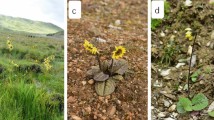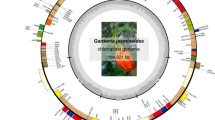Abstract
Main conclusion
The complete chloroplast genome of two colchicine medicinal plants is reported for the first time. Deletion of ycf 15 gene occurred only in Colchicum but not in Gloriosa and suggests this as a potential marker for delineating the two species.
Colchicum autumnale L. and Gloriosa superba L. are well-known sources of colchicine, a type of alkaloid and an ancient anti-inflammatory drug used to prevent gout. Accordingly, this alkaloid has been used as a chemical marker for identifying the expanded Colchicaceae family. In the present study, we report the complete chloroplast genome (cpDNA) sequence of two colchicine medicinal plants (G. superba and C. autumnale) that belong to the tribe Colchiceae of the Colchicaceae family. In C. autumnale, the circular double-stranded cpDNA sequence of 156,462 bp consists of two inverted repeat (IR) regions of 27,741 bp each, a large single-copy region (LSC) of 84,246 bp, and a small single-copy region (SSC) of 16,734 bp. The cpDNA sequence of G. superba is longer than that of C. autumnale (157,924 bp), which consists of two IRs (28,063 bp), an SSC (16,786 bp), and an LSC (85,012 bp). Significant structural differences between them were observed in the ycf15 gene. ycf15 gene was absent from C. autumnale cpDNA and affected the length of the chloroplast genome between the species. Furthermore, this gene loss event was specific to the expanded genus of Colchicum sensu Vinnersten and Manning. Therefore, this gene may be an effective and powerful molecular marker for identifying the Colchicum genus within the family.






Similar content being viewed by others
References
Ade R, Rai MK (2010) Review: colchicine, current advances and future prospects. Bioscience 2(2):90–96
Baker J (2001) The medicinal flora of Britain and Northwestern Europe. Winter Press, UK, p 507
Bodin SS, Kim JS, Kim JH (2013) Complete chloroplast genome of Chionographis japonica (Willd.) Maxim (Melanthiaceae): comparative genomics and evaluation of universal primers of Liliales. Plant Mol Biol Rep 31(6):1407–1421
Brown D (1995) Encyclopedia of herbs and their uses. Dorling kindersley limited, London, pp 423–425
Chen S, Li X, Guo X, Li Q (2011) An introduction to the medicinal plant genome project. Front Med 5(2):178–184
Conant GC, Wolfe KH (2008) GenomeVx: simple web-based creation of editable circular chromosome maps. Bioinformatics 24:861–862
Degtjareva G, Logacheva M, Samigullin T, Terentieva E, Valiejo-Roman C (2012) Organization of chloroplast psbA-trnH intergenic spacer in dicotyledonous angiosperms of the family Umbelliferae. Biochemistry (Mosc) 77(9):1056–1064
del-Hoyo A, Pedrola-Monfort J (2008) Phylogeny of Androcymbium (Colchicaceae) based on morphology and DNA sequences. Plant Syst Evol 273:151–167
Do HDK, Kim JS, Kim JH (2013) Comparative genomics of four Liliales families inferred from the complete chloroplast genome sequence of Veratrum patulum O. Loes. (Melanthiaceae). Gene 530(3):229–235
Do HDK, Kim JS, Kim JH (2014) A trnI-CAU triplication event in the complete chloroplast genome of Paris verticillata M. Bieb. (Melanthiaceae, Liliales). Genome Biol Evol 6(7):1699–1706
Doyle JJ, Davis JI, Soreng RJ, Garvin D, Anderson MJ (1992) Chloroplast DNA inversions and the origin of the grass family (Poaceae). Proc Natl Acad Sci USA 89:7722–7726
Edgar RC (2004) MUSCLE: multiple sequence alignment with high accuracy and high throughout. Nucleic Acids Res 32(5):1792–1797
GEC, GUIDE, MSU (2002) Conservation of rare and endangered biodiversity of Gujarat. A final report by Gujarat ecological commission. Gujarat, India, pp 428
Goulding S, Olmstead R, Morden C, Wolfe K (1996) Ebb and flow of the chloroplast inverted repeat. Mol Gen Genet 252:195–206
Guo X, Castillo-Ramirez S, Gonzalez V et al (2007) Rapid evolutionary change of common bean (Phaseolus vulgaris L.) plastome, and the genomic diversification of legume chloroplasts. BMC Genom 8:228
Hachtel W, Neuss A, Vomstein J (1991) A Chloroplast DNA inversion marks an evolutionary split in the genus Oenothera. Evolution 45:1050–1052
Hall TA (1999) BioEdit: a user-friendly biological sequence alignment editor and analysis program for Windows 95/98/NT. Nucleic Acids Symp Ser 41:95–98
Hoot SB, Palmer JD (1994) Structural rearrangements, including parallel inversions, within the chloroplast genome of anemone and related genera. J Mol Evol 38:274–281
Jansen RK, Palmer JD (1987) A chloroplast DNA inversion marks an ancient evolutionary split in the sunflower family (Asteraceae). Proc Natl Acad Sci USA 84:5818–5822
Katti MV, Ranjekar PK, Gupta VS (2001) Differential distribution of simple sequence repeats in eukaryotic genome sequences. Mol Biol Ecol 18:1161–1167
Kim JS, Kim JH (2013) Comparative genome analysis and phylogenetic relationship of order Liliales insight from the complete plastid genome sequences of two lilies (Lilium longiflorum and Alstroemeria aurea). PLoS One 8(6):e68180
Kim KJ, Lee HL (2004) Complete chloroplast genome sequences from Korean ginseng (Panax schinseng Nees) and comparative analysis of sequence evolution among 17 vascular plants. DNA Res 11:247–261
Kim KY, Schumacher HR, Hunsche E, Wertheimer AI, Kong SX (2003) A literature review of the epidemiology and treatment of acute gout. Clin Ther 25:1593–1617
Kim KJ, Choi KS, Jansen RK (2005) Two chloroplast DNA inversions originated simultaneously during the early evolution of the sunflower family (Asteraceae). Mol Biol Evol 22:1783–1792
Kurtz S, Schleiermacher C (1999) REPuter: fast computation of maximal repeats in complete genomes. Bioinformatics 15:426–427
Lange U, Schumann C, Schmidt KL (2001) Current aspects of colchicine therapy, classical indications and new therapeutic uses. Eur J Med Res 6:150–160
Lee HL, Jansen RK, Chumley TW, Kim KJ (2007) Gene relocations within chloroplast genomes of Jasminum and Menodora (Oleaceae) are due to multiple, overlapping inversions. Mol Biol Evol 24:1161–1180
Librado P, Rozas J (2009) DnaSP v5. A software for comprehensive analysis of DNA polymorphism data. Bioinformatics 25:1451–1452
Liu J, Qi ZC, Zhao YP, Fu CX, Xiang QY (2012) Complete cpDNA genome sequence of Smilax china and phylogenetic placement of Liliales—influences of gene partitions and taxon sampling. Mol Phylogenet Evol 64(3):545–562
Liu Y, Huo N, Dong L, Wang Y, Zhang S et al (2013) Complete chloroplast genome sequences of Mongolia medicine Artemisia frigida and phylogenetic relationships with other plants. PLoS One 8(2):e57533
McCoy S, Kuehl J, Boore J, Raubeson L (2008) The complete plastid genome sequence of Welwitschia mirabilis: an unusually compact plastome with accelerated divergence rates. BMC Evol Biol 8:130–146
Millen RS, Olmstead RG, Adams KL, Palmer JD, Lao NT et al (2001) Many parallel losses of infA from chloroplast DNA during angiosperm evolution with multiple independent transfers to the nucleus. Plant Cell 13(3):645–658
Nguyen PAT, Kim JS, Kim JH (2013) Molecular phylogenetic relationship and implications for the circumscription of Colchicaceae (Liliales). Bot J Linn Soc 172:255–269
Odintsova MS, Yurina NP (2006) Chloroplast genomics of land plants and algae, biotechnological applications of photosynthetic proteins: biochips, biosensors and biodevices. Springer, US, pp 57–72
Palmer JD (1991) Plastid chromosomes: structure and evolution. In: Bogorad L (ed) Molecular biology of plastids. Academic Press, San Diego, pp 5–53
Pang X, Liu C, Shi L, Liu R, Liang D et al (2012) Utility of the trnH–psbA intergenic spacer region and its combinations as plant DNA barcodes: a meta-analysis. PLoS One 7(11):e48833
Plunkett G, Downie S (2000) Expansion and contraction of the chloroplast inverted repeat in Apiaceae subfamily Apioideae. Syst Bot 25:648–667
Qian J, Song J, Gao H, Zhu Y, Xu J et al (2013) The complete chloroplast genome sequence of the medicinal plant Salvia miltiorrhiza. PLoS One 8(2):e57607
Rajendrakumar P, Biswal AK, Balachandran SM, Srinivasarao K, Sundaram RM (2007) Simple sequence repeats in organellar genomes of rice: frequency and distribution in genic and intergenic regions. Bioinformatics 23:1–4
Raubeson LA, Jansen RK (2005) Chloroplast genomes of plants. In: Henry RJ (ed) Plant diversity and evolution: genotypic and phenotypic variation in higher plants. CABI, Cambridge, pp 45–68
Raubeson LA, Peery R, Chumley TW, Dziubek C, Fourcade HM, Boore JL, Jansen RK (2007) Comparative chloroplast genomics: analyses including new sequences from the angiosperms Nuphar advena and Ranunculus macranthus. BMC Genomics 8(1):174
Ruhlman TA, Jansen (2014) The plastid genomes of flowering plant. Methods Mol Biol 1132:3–38
Saski C, Lee SB, Daniell H, Wood TC, Tomkins J, Kim HG, Jansen RK (2005) Complete chloroplast genome sequence of Glycine max and comparative analyses with other legume genomes. Plant Mol Biol 59:309–322
Schattner P, Brooks AN, Lowe TM (2005) The tRNAscan-SE, snoscan and snoGPS web servers for the detection of tRNAs and snoRNAs. Nucleic Acids Res 33:686–689
Schmitz-Linneweber C, Maier RM, Alcaraz JP et al (2001) The plastid chromosome of spinach (Spinacia oleracea): complete nucleotide sequence and gene organization. Plant Mol Biol 45(3):307–315
Shanker A, Singh A, Sharma V (2007) In silico mining in expressed sequences of Neurospora crassa for identification and abundance of microsatellites. Microbiol Res 162:250–256
Steane DA (2005) Complete nucleotide sequence of the chloroplast genome from the Tasmanian blue gum, Eucalyptus globulus (Myrtaceae). DNA Res 12(3):215–220
Tamura K, Peterson D, Peterson N, Stecher G, Nei M, Kumar S (2011) MEGA5: molecular evolutionary genetics analysis using maximum likelihood, evolutionary distance, and maximum parsimony methods. Mol Biol Evol 28:2731–2739
Temnykh et al (2001) Computational and experimental analysis of microsatellites in rice (Oryza sativa L.): frequency, length variation, transposon associations, and genetic marker potential. Genome Res 11:1441–1452
Tian X, Li DZ (2002) Application of DNA sequences in plant phylogenetic study. Acta Bot Yunnan 24:170–184
Touitou S, Savic RJ, Mathews G, Grateau MF, McDermott (2008) Fifth international congress on familial Mediterranean fever and systemic auto inflammatory diseases. Expert Rev Clin Immunol 4:425–428
Untergrasser A et al (2012) Primer3-new capabilities and interfaces. Nucleic Acids Res 40(15):e115
Vinnersten A, Larsson S (2010) Colchicine is still a chemical marker for the expanded Colchicaceae. Biochem Syst Ecol 38:1193–1198
Vinnersten A, Manning J (2007) A new classification of Colchicaceae. Taxon 56:171–178
Wakasugi T, Tsudzuki J, Ito S, Nakashima K, Tsudzuki T et al (1994) Loss of all ndh genes as determined by sequencing the entire chloroplast genome of the black pine Pinus thunbergii. Proc Natl Acad Sci USA 91:9794–9798
Wu CS, Lai YT, Lin CP, Wang YN, Chaw SM (2009) Evolution of reduced and compact chloroplast genomes (cpDNAs) in gnetophytes: selection toward a lower-cost strategy. Mol Phylogenet Evol 52:115–124
Yang ZH, Nielsen R (2000) Estimating synonymous and nonsynonymous substitution rates under realistic evolutionary models. Mol Biol Evol 17:32–43
Yang M, Zhang X, Liu G, Yin Y, Chen K, Yun Q, Zhao D, Al-Mssallem IS, Yu J (2010) The complete chloroplast genome sequence of date palm (Phoenix dactylifera L.). PLoS One 5(9):e12762
Yang JB, Tang M, Li HT, Zhang JR, Li DJ (2013) Complete chloroplast genome of the genus Cymbidium: lights into the species identification, phylogenetic implications and population genetic analyses. BMC Evol Biol 13:84
Acknowledgments
This study was supported by the National Research Foundation of Korea (NRF) Grant Foundation (MEST 2010-002913).
Author information
Authors and Affiliations
Corresponding author
Additional information
P. A. T. Nguyen and J. S. Kim contributed equally to this study.
Electronic supplementary material
Below is the link to the electronic supplementary material.
Rights and permissions
About this article
Cite this article
Nguyen, P.A.T., Kim, J.S. & Kim, JH. The complete chloroplast genome of colchicine plants (Colchicum autumnale L. and Gloriosa superba L.) and its application for identifying the genus. Planta 242, 223–237 (2015). https://doi.org/10.1007/s00425-015-2303-7
Received:
Accepted:
Published:
Issue Date:
DOI: https://doi.org/10.1007/s00425-015-2303-7




